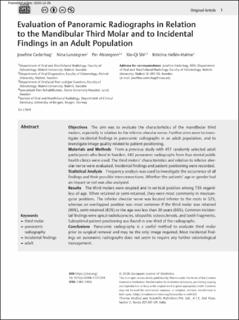| dc.contributor.author | Cederhag, Josefine | |
| dc.contributor.author | Lundegren, Nina | |
| dc.contributor.author | Alstergren, Per | |
| dc.contributor.author | Shi, Xie-Qi | |
| dc.contributor.author | Hellén-Halme, Kristina | |
| dc.date.accessioned | 2021-05-14T07:49:31Z | |
| dc.date.available | 2021-05-14T07:49:31Z | |
| dc.date.created | 2021-01-18T12:30:34Z | |
| dc.date.issued | 2020 | |
| dc.identifier.issn | 1305-7456 | |
| dc.identifier.uri | https://hdl.handle.net/11250/2755251 | |
| dc.description.abstract | Objectives
The aim was to evaluate the characteristics of the mandibular third molars, especially in relation to the inferior alveolar nerve. Further aims were to investigate incidental findings in panoramic radiographs in an adult population, and to investigate image quality related to patient positioning.
Materials and Methods
From a previous study with 451 randomly selected adult participants who lived in Sweden, 442 panoramic radiographs from four dental public health clinics were used. The third molars’ characteristics and relation to inferior alveolar nerve were evaluated. Incidental findings and patient positioning were recorded.
Statistical Analysis
Frequency analysis was used to investigate the occurrence of all findings and their possible interconnections. Whether the patients’ age or gender had an impact or not was also analyzed.
Results
The third molars were erupted in vertical position among 73% regardless of age. When retained or semi-retained, they were most commonly in mesioangular positions. The inferior alveolar nerve was located inferior to the roots in 52%, whereas an overlapped position was most common if the third molar was retained (90%), semi-retained (83%) or the age was less than 30 years (66%). Common incidental findings were apical radiolucencies, idiopathic osteosclerosis, and tooth fragments. Suboptimal patient positioning was found in one-third of the radiographs.
Conclusions
Panoramic radiography is a useful method to evaluate third molar prior to surgical removal and may be the only image required. Most incidental findings on panoramic radiographs does not seem to require any further odontological management. | en_US |
| dc.language.iso | eng | en_US |
| dc.publisher | Thieme Open | en_US |
| dc.rights | Attribution-NonCommercial-NoDerivatives 4.0 Internasjonal | * |
| dc.rights.uri | http://creativecommons.org/licenses/by-nc-nd/4.0/deed.no | * |
| dc.title | Evaluation of Panoramic Radiographs in Relation to the Mandibular Third Molar and to Incidental Findings in an Adult Population | en_US |
| dc.type | Journal article | en_US |
| dc.type | Peer reviewed | en_US |
| dc.description.version | publishedVersion | en_US |
| dc.rights.holder | Copyright 2020. European Journal of Dentistry. | en_US |
| cristin.ispublished | true | |
| cristin.fulltext | original | |
| cristin.qualitycode | 1 | |
| dc.identifier.doi | 10.1055/s-0040-1721294 | |
| dc.identifier.cristin | 1873163 | |
| dc.source.journal | European Journal of Dentistry | en_US |
| dc.identifier.citation | European Journal of Dentistry, 2020. | en_US |

